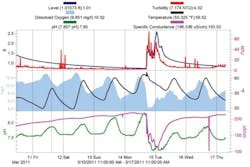Cost-Effective Monitoring Strategies in MS4 Programs
In October 2001, the Alabama Department of Environmental Management (ADEM) issued NPDES Permit ALS000001 for the Birmingham-area municipal separate storm sewer system (MS4) and Jefferson County. The city of Hoover, the sixth largest city in Alabama, was required to comply with permit requirements.
The requirements included identifying monitoring locations representative of various land use types, and collecting storm water samples during a storm event at each location. For a storm event to qualify for sampling, it had to be preceded by 72 hours of dry weather and produce a minimum of 0.10 in. of rainfall. At a minimum, the permit required sampling at each location on an annual basis, resulting in a single data point.
The city of Hoover found that the single data point provided little value for evaluating the effectiveness of its MS4 program. In 2007, the city withdrew from the Storm Water Management Authority (SWMA) and assumed responsibility for developing and implementing its own MS4 program. ADEM administratively extended the requirements and conditions of NPDES Permit ALS000001 until an individual NPDES permit could be issued to the city of Hoover.
As part of its new program, the city needed to satisfy regulatory requirements within its funding constraints. An evaluation of SWMA activities was performed, prioritizing each activity based on its need for compliance and associated costs. The monitoring requirements of the original permit, developed more than a decade earlier, were based on available technology at the time. The city identified significant advancements in monitoring technologies, and evaluated new instruments and techniques that might prove more cost effective, while producing data that better represented stream conditions.
The state’s water quality criteria, 303(d) list, total maximum daily load list and pollutants of concern were evaluated to determine sampling parameter requirements. Common required parameters included dissolved oxygen, temperature, turbidity, conductivity, pH and level. These base parameters provided a general insight to stream health and/or could be used as surrogate parameters to evaluate pollutants of concern. While continuous monitoring did not provide as many parameters as grab sampling, grab sampling resulted in limited or skewed data. The city determined that to get more value, more data was needed.
The In-Situ TROLL 9500 multiparameter sonde with a telemetry system was selected. A 15-minute reading interval, with a push to the web every hour, would produce approximately 8,760 hourly data points for each parameter per year, providing a much clearer picture of stream conditions. The unit also was capable of sending alerts when a preset trigger condition was met. The city then could deploy staff to investigate the situation to determine if a non-storm water discharge was occurring.
The elimination of manual grab samples during qualifying storm events was another benefit of continuous monitoring. The city’s cost-benefit analysis over a five-year period, including maintenance, revealed that the costs of establishing a continuous monitoring station was approximately 30% less than the flow composite sampling method and produced significantly more data. As a result, the city moved forward to obtain ADEM approval to modify its monitoring program.
In 2010, the city of Hoover received regulatory approval and installed two continuous monitoring stations; a third site was added in 2013. Over a six-year period, the continuous monitoring stations provided valuable insight into what was happening within Patton Creek and helped the city eliminate non-storm water discharges.
In April 2016, the city replaced its aging TROLL 9500 instruments with In-Situ Aqua TROLL 600 mulitparameter sondes. Advancements in sensor and antifouling technology incorporated into this model’s design have further reduced program costs by extending deployment times and reducing field visits for maintenance.


